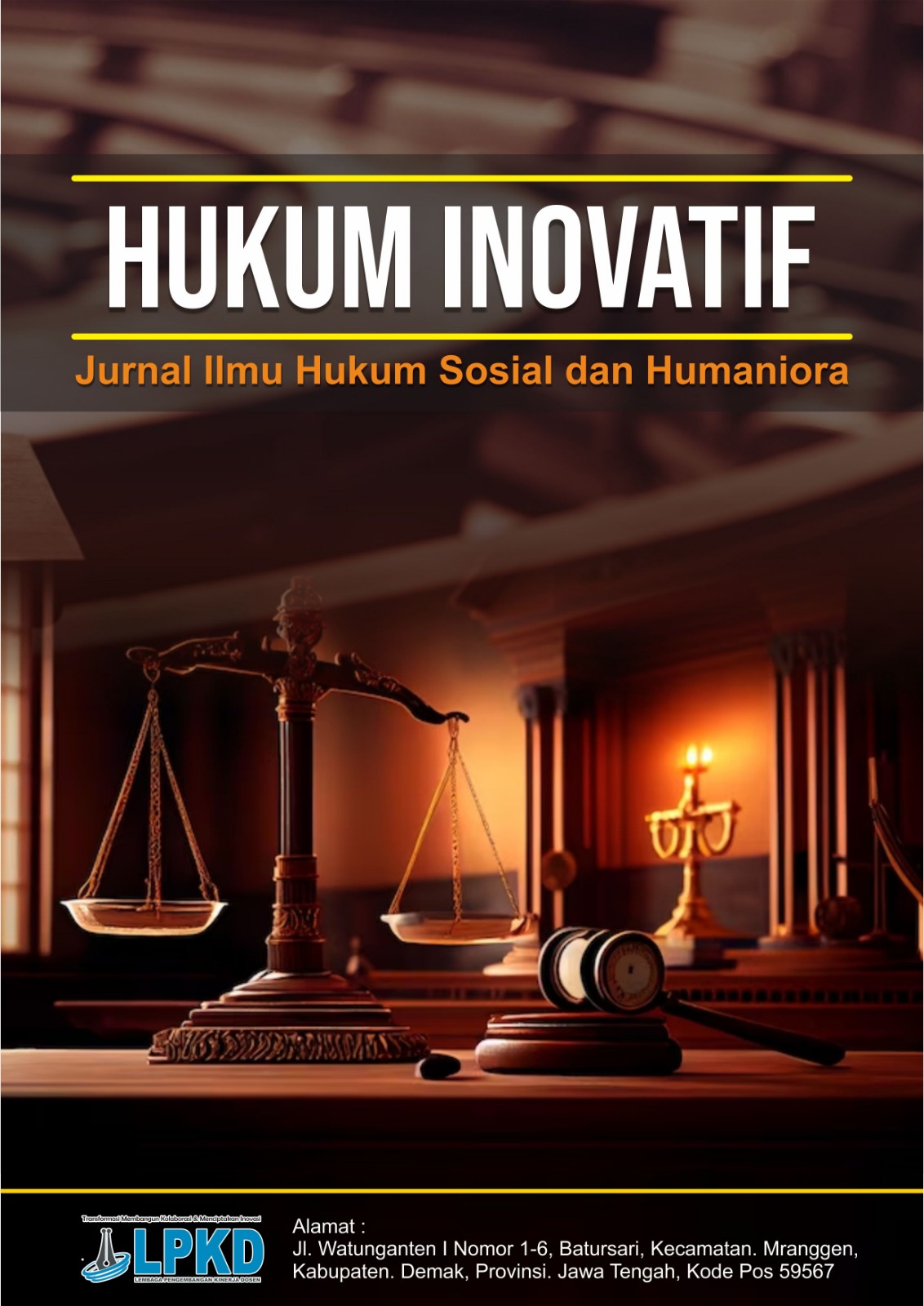Teori Hukum Penitensier Terhadap Pelaku Kekerasan Seksual Terhadap Anak
DOI:
https://doi.org/10.62383/humif.v1i3.337Keywords:
Legal Protection, Child Victims of Crime, PenitentiaryAbstract
Children have human rights, just like adults have, to protect children's rights, not many parties think about it and take concrete steps. Likewise, efforts to protect children's rights are violated by the State, adults, their own environment or their parents who do not really pay attention to the interests of the child's future. Child protection is not only attached to the individual child, but also to other humans. This is a consequence of humans as social creatures who cannot be separated from other humans. Criminal law then exists to regulate various acts that violate human rights which are then punished. Of course, criminal law cannot be implemented properly if there is no other legal knowledge that accompanies it, including penitentiary law which is known as Penal Law or legal science that studies punishment. The Penitentiary Law is not a legal rule that can immediately punish criminals arbitrarily, but requires human rights to be taken into account. This article focuses on whether penitentiary laws violate human rights or not. The purpose of this paper is to examine in more depth the effectiveness of penitentiary laws in sanctioning sexual crime perpetrators and protecting sexual crime victims. The research method used is normative law with library research techniques analyzed qualitatively using a statutory approach and a conceptual approach. The results of the research conclude that the Penitentiary Law is a regulation that seeks to continue to fight for the human rights of people who have been violated by the perpetrator of a crime by punishing them, but the model of punishment given still pays attention to the human rights of the perpetrator of the crime being punished.
References
Buku:
Adami Chazawi, Tindak Pidana Mengenal Kesopanan, Bandung Angkasa, 2005.
Dona Raisa Monica dan Diah Gustiniati M., 2018, Pengantar Hukum Penitensier dan Sistem Pemasyarakatan Indonesia, Anugrah Utama Raharja, Bandar Lampung
Maidin Gultom, 2014, Perlindungan Hukum Terhadap Anak dan Perempuan, Bandung: PT Refika Aditama
Marlina, 2011, Hukum Penitersier, Refika Aditama, Medan.
Moelyatno, Asas-Asas Hukum Pidana, 1993. Jakarta: Rineka Cipta
Mompang L. Panggabean, 2005, Pokok-Pokok Hukum Penitensier di Indonesia, Uki Press, Jakarta
Putje MFR, Badu LW, Mantali ARY. Kendala Yang Dihadapi Unit Ppa Polres Kota Gorontalo Kota
P.A.F. Lamintang, Dasar-Dasar Hukum Pidana Indonesia, Citra Aditya Bakti, Bandung, 2011. Dalam Pemenuhan Hak Anak Sebagai Korban Tindak Pidana Pencabulan. Jurnal Ilmiah Multidisiplin Keilmuan Mandira Cendikia. Vol. 2. No. 7. 2024
SOEKANTO, Soerjono. Faktor-faktor yang mempengaruhi penegakan hukum. 2004.
Suratman dan H. Philips Dillah, 2014, Metode Penelitian Hukum, Alfabeta, Bandung
Peraturan: Undang-Undang Nomor 2 Tahun 2002 Tentang Kepolisian Negara Republik Indonesia
Undang-Undang Republik Indonesia Nomor 35 Tahun 2014 tentang Perubahan Atas Undang-Undang Nomor 23 Tahun 2002 tentang Perlindungan Anak
Undang-Undang Nomor 8 Tahun 1981 Tentang Kitab Undang-Undang Hukum Acara Pidana Kitab Undang-Undang Hukum Pidana
Undang-Undang Republik Indonesia Nomor 35 Tahun 2014 Tentang Perubahan Atas Undang-Undang Nomor 23 Tahun 2002 Tentang Perlindungan Anak.
Undang-Undang Dasar Negara Republik Indonesia Tahun 1945 Pasal 2 dan 3 Undang-Undang Republik Indonesia Nomor 35 Tahun 2014 tentang Perubahan Atas Undang-Undang Nomor 23 Tahun 2002 tentang Perlindungan Anak
Undang-Undang No. 13 Tahun 2006 tentang Perlindungan Saksi Dan Korban.
Lembaran Negara Republik Indonesia. Tahun 2006. No 64.
Undang-Undang No. 35 tahun 2014 tentang Perubahan atas Undang Undang No. 23 tentang Perlindungan Anak. Lembaran Negara Republik Indonesia. Tahun 2014. No 297.op.cit.
Undang-Undang 23 Tahun 2004 tentang Penghapusan Kekerasan Dalam Rumah Tangga. Lembar Negara Republik Indonesia. Tahun 2004. No 95.op.cit.
Undang-Undang N0 39 Tahun 1999 tentang Hak Asasi Manusia. Lembaran Negara Republik Indonesia. Tahun 1999. No 165.
Undang-Undang No.11 tahun 2012 tentang Sistem Peradilan Pidana Anak.
Lembaran Negara Republik Indonesia. Tahun 2012. No. 153.op.cit
Undang-Undang No. 35 tahun 2014 tentang Perubahan atas Undang Undang No. 23 tentang Perlindungan Anak. Lembaran Negara Republik Indonesia. Tahun 2014. No 297. Op.cit
Undang-Undang No. 35 tahun 2014 tentang Perubahan atas Undang-Undang No. 23 tentang Perlindungan Anak. Lembaran Negara Republik Indonesia. Tahun 2014. No 297.op.cit
Undang-Undang Hukum Pidana. Lembaran Negara Republik Indonesia. Tahun 1976. No 26.op.cit
Undang-Undang 23 Tahun 2004 tentang Penghapusan Kekerasan Dalam Rumah Tangga. Lembar Negara Republik Indonesia. Tahun 2004. No 95.
Undang-Undang No.11 tahun 2012 tentang Sistem Peradilan Pidana Anak.
Lembaran Negara Republik Indonesia. Tahun 2012. No. 153.
Internet:
Berrick, J. D., & Gilbert, N. (2018). Child Maltreatment Research, Policy, and Practice for the Next Decade: Out of Crisis. Journal of the Society for Social Work and Research, 9(2), 163–186. doi: 10.1086/697585
Carr, A., & Vandiver, D. M. (2001). Risk and Protective Factors among Childreand Adolescents Who Have Been Sexually Abused: A Review and Meta Analysis. Trauma, Violence, & Abuse, 2(2), 91–118. doi: 10.1177/1524838001002002001
Downloads
Published
How to Cite
Issue
Section
License
Copyright (c) 2024 Hukum Inovatif : Jurnal Ilmu Hukum Sosial dan Humaniora

This work is licensed under a Creative Commons Attribution-ShareAlike 4.0 International License.






